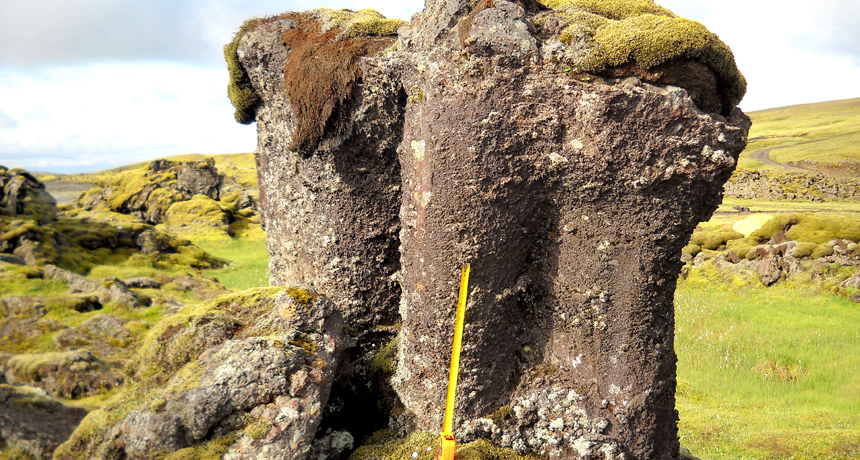Water helped erect Iceland’s lava towers
Science pointed the way to understanding why these curious natural pillars form

Lava pillars, seen here, formed in an Icelandic valley when molten rock flowed around rising columns of heated water. Water cooled the lava into rocky crusts, creating pillars.
Courtesy of T. Gregg
Share this:
- Share via email (Opens in new window) Email
- Click to share on Facebook (Opens in new window) Facebook
- Click to share on X (Opens in new window) X
- Click to share on Pinterest (Opens in new window) Pinterest
- Click to share on Reddit (Opens in new window) Reddit
- Share to Google Classroom (Opens in new window) Google Classroom
- Click to print (Opens in new window) Print
Unusual hollow pillars of lava rise some 2.5 meters (roughly 8 feet) above the floor of picturesque Skaelingar Valley in Iceland. Though hikers have long been familiar with these rocky sculptures, scientists had largely ignored them — until now. A team of geologists at last offers a scientific explanation for the weird columns. Writing in the Aug. 15 Journal of Volcanology and Geothermal Research, they propose that the lava pillars formed when molten rock oozed over soggy land.
In 1783, a long-narrow crack, called Laki, opened in Earth’s surface. For 8 solid months it spewed lava into southern Iceland. The eruption released lava — an estimated 14 cubic kilometers (or almost 500 billion cubic feet) of it.
This molten rock pushed up the Skaelingar Valley. One blob at a time, it crept forward over water-logged ground. Usually these blobs — called lobes — will merge. But patches of wet earth between the lobes cooled the hot rock. This formed solid crusts, explains Tracy Gregg. The University of Buffalo, N.Y., geologist co-authored a new paper with a graduate student at the school. It describes the tower-building process.
Those crusts appear to have blocked the lava’s flow, Gregg says. This would have rerouted the lobes around the wet spots. As the lobes inched around the edges of a soggy spot, the lava hardened, creating a crusty ring.
Inside the ring, the lava’s heat caused some groundwater to rise to the surface. This caused the crust to build up as lava continued to pump into the valley. Eventually, when most of the lava had drained away, all that remained were the hollow crusty towers, Gregg proposes. In some ways, they resemble the papier mâché shells of deflated balloons.
Similar underwater lava structures rise from various spots on the ocean floor. Gregg first recognized the similarity of Iceland’s lava pillars to those undersea towers while hiking through the Skaelingar Valley in the mid-1990s. What she saw then, and never forgot, inspired her new investigation of these natural sculptural oddities.
Power Words
geology The study of Earth’s physical structure and substance, its history and the processes that act on it. People who work in this field are known as geologists. Planetary geology is the science of studying the same things about other planets.
graduate student Someone working toward an advanced degree by taking classes and performing research. This work is done after the student has already graduated from college (usually with a four-year degree).
groundwater Water held underground in the soil or in pores and crevices in rock.
lava Molten rock that comes up from the mantle, through Earth’s crust, and out of a volcano.
volcanism The processes by which volcanoes form and change over time. Scientists who study this are known as volcanologists and their field of science is known as volcanology.







